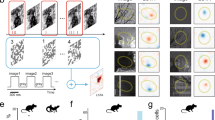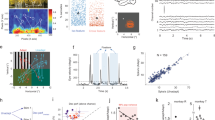Abstract
Owing to the limited dynamic range of a neuron's output, neural circuits are faced with a trade-off between encoding the full range of their inputs and resolving gradations among those inputs. For example, the ambient light level varies daily over more than nine orders of magnitude1, whereas the firing rate of optic nerve fibres spans less than two2. This discrepancy is alleviated by light adaptation3: as the mean intensity increases, the retina becomes proportionately less sensitive. However, image statistics other than the mean intensity also vary drastically during routine visual processing. Theory predicts that an efficient visual encoder should adapt its strategy not only to the mean, but to the full shape of the intensity distribution4–6. Here we report that retinal ganglion cells, the output neurons of the retina, adapt to both image contrast—the range of light intensities—and to spatial correlations within the scene, even at constant mean intensity. The adaptation occurs on a scale of seconds, one hundred times more slowly than the immediate light response, and involves 2–5-fold changes in the firing rate. It is mediated within the retinal network: two independent sites of modulation after the photo-receptor cells appear to be involved. Our results demonstrate a remarkable plasticity in retinal processing that may contribute to the contrast adaptation of human vision7.
This is a preview of subscription content, access via your institution
Access options
Subscribe to this journal
Receive 51 print issues and online access
$199.00 per year
only $3.90 per issue
Buy this article
- Purchase on Springer Link
- Instant access to full article PDF
Prices may be subject to local taxes which are calculated during checkout
Similar content being viewed by others
References
Rushton, W. A. Visual Adaptation (The Ferrier Lecture, 1962). Proc. R. Soc. Lond. B 162, 20–46 (1965).
Barlow, H. B. Critical limiting factors in the design of the eye and visual cortex (The Ferrier Lecture, 1980). Proc. R. Soc. Lond. B 212, 1–34 (1981).
Shapley, R. & Enroth-Cugell, C. Visual Adaptation and Retinal Gain Controls. Progr. Ret. Res. 3, 263–346 (1984).
Laughlin, S. A simple coding procedure enhances a neuron's information capacity. Z. Naturforsch. 36, 910–912 (1981).
de Ruyter van Steveninck, R. R., Bialek, W., Potters, M. & Carlson, R. H. Statistical adaptation and optimal estimation in movement computation by the blowfly visual system. Proc IEEE Int. Conf. Systems, Man, and Cybernetics 302–308 (1994).
DeWeese, M. & Bialek, W. Information flow in sensory neurons. Il Nuovo Cimento 17D, 733–738 (1995).
Blakemore, C. & Campbell, F. W. On the existence of neurones in the human visual system selectively sensitive to the orientation and size of retinal images. J. Physiol. 203, 237–260 (1969).
Ohzawa, I., Sclar, G. & Freeman, R. D. Contrast gain control in the cat's visual system. J. Neurophysiol. 54, 651–667 (1985).
Sakai, H. M. & Naka, K. Signal transmission in the catfish retina. V. Sensitivity and circuit. J. Neurophysiol. 58, 1329–1350 (1987).
Meister, M., Pine, J. & Baylor, D. A. Multi-neuronal signals from the retina: acquisition and analysis. J. Neurosci. Meth. 51, 95–106 (1994).
Shapley, R. M. & Victor, J. D. The effect of contrast on the transfer properties of cat retinal ganglion cells. J. Physiol. 285, 275–298 (1978).
Victor, J. D. The dynamics of the cat retinal X cell centre. J. Physiol. 386, 219–246 (1987).
Wang, J.-L. & Naka, K.-I. Contrast gain control in the lower vertebrates retinas. Soc. Neurosci. Abstr. 21, 1644 (1995).
Copenhagen, D. R. & Green, D. G. The absence of spread of adaptation between rod photoreceptors in turtle retina. J. Physiol. 369, 161–181 (1985).
Dacheux, R. F. & Raviola, E. Horizontal cells in the retina of the rabbit. J. Neurosci. 2, 1486–1493 (1982).
Hare, W. A. & Owen, W. G. Spatial organization of the bipolar cell's receptive field in the retina of the tiger salamander. J. Physiol. 421, 223–245 (1990).
Werblin, F., Maguire, G., Lukasiewicz, P., Eliasof, S. & Wu, S. M. Neural interactions mediating the detection of motion in the retina of the tiger salamander. Visual Neuosci. 1, 317–329 (1988).
Bloomfield, S. A. Relationship between receptive and dendritic field size of amacrine cells in the rabbit retina. J. Neurophysiol. 68, 711–725 (1992).
Barlow, H. B. & Hill, R. M. Evidence for a physiological explanation of the waterfall phenomenon and figural after-effects. Nature 200, 1345–1347 (1963).
Schieting, S. & Spillmann, L. Flicker adaptation in the peripheral retina. Vision Res. 27, 277–284 (1987).
Albrecht, D. G., Farrar, S. B. & Hamilton, D. B. Spatial contrast adaptation characteristics of neurones recorded in the cat's visual cortex. J. Physiol. 347, 713–739 (1984).
Ho, W. A. & Berkley, M. A. Evoked potential estimates of the time course of adaptation and recovery to counterphase gratings. Vision Res. 28, 1287–1296 (1988).
Giaschi, D., Douglas, R., Marlin, S. & Cynader, M. The time course of direction-selective adaptation in simple and complex cells in cat striate cortex. J. Neurophysiol. 70, 2024–2034 (1993).
Barlow, H. B. & Bridley, G. S. Inter-ocular transfer of movement aftereffects during pressure binding of the stimulated eye. Nature 200, 1347 (1963).
Meister, M., Lagnado, L. & Baylor, D. A. Concerted signaling by retinal ganglion cells. Science 270, 1207–1210 (1995).
Brainard, D. Calibration of a computer controlled color monitor. Color Res. Appl. 14, 23–34 (1989).
Dawis, S. M. Polynomial expressions of pigment nomograms. Vision Res. 21, 1427–1430 (1981).
Nuboer, J. F. W. & Moed, P. J. Increment-threshold spectral sensitivity in the rabbit. J. Comp. Physiol. 151, 353–358 (1983).
Author information
Authors and Affiliations
Rights and permissions
About this article
Cite this article
Smirnakis, S., Berry, M., Warland, D. et al. Adaptation of retinal processing to image contrast and spatial scale. Nature 386, 69–73 (1997). https://doi.org/10.1038/386069a0
Received:
Accepted:
Issue Date:
DOI: https://doi.org/10.1038/386069a0
This article is cited by
-
Opposite forms of adaptation in mouse visual cortex are controlled by distinct inhibitory microcircuits
Nature Communications (2022)
-
Strong liberal representationalism
Phenomenology and the Cognitive Sciences (2022)
-
A phototransistor with visual adaptation
Nature Electronics (2021)
-
An organic transistor with light intensity-dependent active photoadaptation
Nature Electronics (2021)
-
Efficient and adaptive sensory codes
Nature Neuroscience (2021)
Comments
By submitting a comment you agree to abide by our Terms and Community Guidelines. If you find something abusive or that does not comply with our terms or guidelines please flag it as inappropriate.



